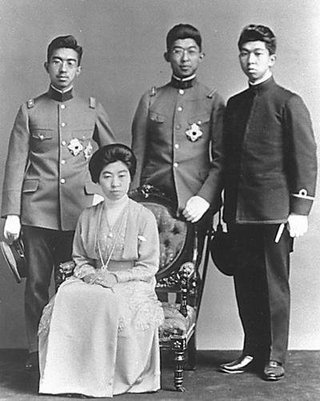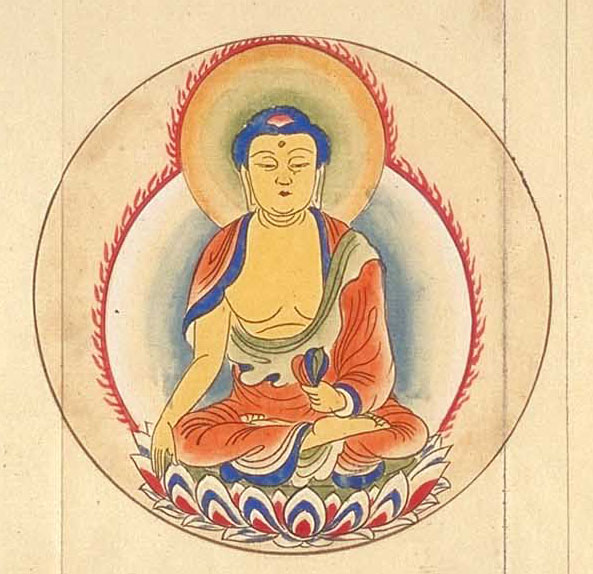History of the Ex-patients of Hansen's disease in Japan, 1863-2001

貞明皇后(1884-1951)、後ろ左より迪宮裕仁親王(みちのみや・ひろひと・しんのう)、秩父宮雍仁親王、高松宮宣仁親王、写真は撮影年代不明:1920年代前半か?、なお貞明皇后の四男・三笠宮崇仁親王は写真には不在
History of the Ex-patients of Hansen's disease in Japan, 1863-2001

貞明皇后(1884-1951)、後ろ左より迪宮裕仁親王(みちのみや・ひろひと・しんのう)、秩父宮雍仁親王、高松宮宣仁親王、写真は撮影年代不明:1920年代前半か?、なお貞明皇后の四男・三笠宮崇仁親王は写真には不在
| 1863 明治維新
1873 ノルウェーのゲルハール・ヘンリック・ア ルマウェル・ハンセン(Gerhard Henrick Armauer Hansen, 1841-1912)、検査した癩患者から細菌(Mycobacterium leprae)を発見したと報告[分類記載の年代は1874]。 It was discovered in 1873 by the Norwegian physician Gerhard Armauer Hansen, who was searching for the bacteria in the skin nodules of patients with leprosy. It was the first bacterium to be identified as causing disease in humans.[4][5][verification needed] The organism has never been successfully grown on an artificial cell culture medium.[2] Instead, it has been grown in mouse foot pads and more recently in nine-banded armadillos because they, like humans, are susceptible to leprosy. This can be used as a diagnostic test for the presence of bacilli in body lesions of suspected leprosy patients. The difficulty in culturing the organism appears to be because it is an obligate intracellular parasite that lacks many necessary genes for independent survival. The complex and unique cell wall that makes members of the genus Mycobacterium difficult to destroy is apparently also the reason for the extremely slow replication rate. - (Mycobacterium leprae) Gerhard Henrik
Armauer Hansen, by Whonamedit? 1879 Hansen gave tissue samples to Albert Neisser (1855-1916), who then successfully stained the bacteria and announced his findings in 1880, claiming to have discovered the disease-causing organism. "Neisser was also the
co-discoverer of the causative agent of leprosy. In 1879 the Norwegian
physician Gerhard Armauer Hansen gave to young Neisser (who had visited
him in Norway to examine some 100 leprosy patients) some tissue samples
of his patients. Neisser successfully stained the bacteria and
announced his findings in 1880, claiming to have discovered the
pathogenesis of leprosy. There was some conflict between Neisser and
Hansen, because Hansen had failed to culture the organism and
demonstrate unequivocally its link to leprosy, although he had observed
the bacterium since 1872." - Albert Neisser. Microbiology of M.leprae, by WHO 1884 6月25日九条 節子(くじょう・さだこ)後の貞明皇后が生まれる 1889 (明22)年フランスパリ外国宣教会(Missions Étrangères de Paris, MEP)のテストウィド神 父(Germain Leger Testvuide, 1849-1891)が御殿場に私立の復生病院を設立(以下:情報ソースは厚生労働省:http://www.mhlw.go.jp/houdou/2003/01/h0131-5/dekigoto.html)。 1894 An abandoned sugar
plantation became the Louisiana Leper Home(→National Hansen's Disease Museum ,
LA, USA) 1895 イギリス人のハンナ・リデルが 熊本に私 立の回春病院を設立。 1896 光田健輔(1876-1964)、済生学舎卒業(医術開業試験合格→帝国大学医科大学選科[病理学]) 1900 2月11日九条 節子15歳で、5歳年上の皇太子嘉仁親王と婚約。同年5月10日、宮中の賢所に於いて、神前で挙式。 1905 リデルの回春病院、英国からの支援の打ち切り。財政援助を求めて日本橋・銀行会館で癩救済講演会(大隈重信/渋沢栄一(Eiichi SHIBUSAWA, 1840-1931)の支援/内務省・窪田衛生局長) 1907 「癩予防に関する件」制定。放浪患者の隔 離がはじまる。(→「ハンセン病に関する 法律」) 1909 全国5カ所(青森、東京、大阪、香川、熊本)で公立 療養所開設。大阪は「近畿、北陸の2府10県が協力して、現在の大阪市西淀川区中島2丁目にあたる場所に、公立のハンセン病療養所「第三区連合府県立外島 保養院」(以下、「外島保養院」)(定員300人) を、隔離収容施設として1909(明治42)年4月に開設」外島保養院について) 1912 7月30日明治天皇崩御。夫・嘉仁親王の皇位継承(践祚)に伴い貞明皇后となる。昭憲皇太后の後継者として、蚕糸・絹業を奨励し、自身も養蚕(皇后御親蚕)に取り組んだ。救癩事業(ハンセン病)に尽くし、灯台守を支援した 1913 ブロニスラウ・ピウスツキ「ギリヤークとアイヌにおけるハンセン病」(1913)ainu_leprosy_Pilsudski.pdf with password をヌシャテル(スイス)にて執筆。 1916 小鹿島慈恵医院が開院
手前:貞明皇后、後ろ左より迪宮裕仁親王(みちのみや・ひろひと・しんのう)、秩父宮雍仁親王、高松宮宣仁親王、写真は撮影年代不明:1920年代前半か?、なお貞明皇后の四男・三笠宮崇仁親王は写真には不在。
1921 [T]he U.S. Public
Health Service took control and the facility became U.S. Marine
Hospital Number 66, the National Leprosarium of the United States(→National Hansen's Disease Museum ,
LA, USA)/ National Hansen's Disease
Program, USA 1925 貞明皇后は、後藤静香[せいこう:1884-1971](「修養団」に傾倒する)が主宰する教化団体希望社を介して「女官一同」の名で、金一封を後藤に贈呈 1926 大正天皇崩御 1930 国立癩療養所長島愛生(あいせい)園設立。台湾総督府は、楽生院を開設。 1931 「癩予防法」制定。癩予防協会設立(皇太后の誕生日6月25日を癩予防デーとする。「ハンセン病を正しく理解する週間」と現在でも続いている)。隔離の対象となる患者 の範囲が広まる/無癩県運動はじまる(→「光田健輔と志賀潔」) 貞明皇太后(節子:1884-1951)が、1932年に大宮御所の歌会で「癩患者を慰めて」と題して「つれづれの友となりても慰めよ行くことかたきわれにかはりて」と詠む。(→厚生労働省「藤楓協会および皇室の役割(pdf)」 ) 1934 台湾に、勅令「らい予防法」公布 1934(昭和9)年9月21日「室戸台風の直撃に
より、防波堤を越えて押し寄せた高波により施設が壊滅し、一瞬にして187人(入所者173人、職員3人、職員家族11人:当時の入所者597人の約3
割)と施設拡張工事関係者9人の命がうばわれてしまいました。療養所が復興するめどはたたず、9月下旬より各地の療養所へ患者を委託するという窮余の策が
講じられました」→1938年、長島に府県立療養所光明園として移転。 1937 パーク・デイビス(英語版)社のエドワード・ティリットソン (Edward Tillitson) とB・F・テュラー (B. F. Tuller) が、グルコスルホンナトリウム(後の商品名「プロミン( Promin, Parke, Davis, & Co)」)を開発。 1937 12月から1938年9月まで改造社による『新万葉集』(本巻9巻、別巻「宮廷篇(へん) 」、補遺「総索引」を加えて全11巻)が編纂、公刊される。本巻の作者は6675人、歌数2万6783首(→「コトバンク:新万葉集」) 1938 小川正子『小島の春』/厚生省の設置(下記) 1月11日:「当時の陸軍大臣寺内寿一の提唱に端を発し、国民の体力向上、結核等伝染病への罹患防止、傷痍軍人や戦死者の遺族に関する行政機関として、内務省から衛生局及び社会局が分離される形で、厚生省が設置」(ウィキ日本語) 1940 全羅南道小鹿島に て第14回日本癩学会(→「 志賀による特別講演「癩研究の十余年」」)。 1941 1938年に長島に移転した、府県立療養所光明園は、1941(昭和16)年7月厚生省へ移管され、国立療養所の邑久光明園となる。 エドマンド・カウドリー (Edmund Cowdry) による、ラットでのハンセン病の研究結果をルイジアナ州カーヴィルにあった国立ハンセン病療養所のガイ・ヘンリー・ファジェット( Guy Henry Faget [1891-1947] of the National Leprosarium in Carville, Louisiana)に報告。 「メイヨー・クリニックにおいて、モルモットを使っ た結核治療についてさらなる研究が行われた。また、ハンセン病と結核はともにマイコバクテリウム属の細菌(それぞれらい菌と結核菌)によって引き起こされ ることがすでに知られていたことから、ルイジアナ州カーヴィルにあった国立ハンセン病療養所のガイ・ヘンリー・ファジェットは、パーク・デイビスにプロミ ンの情報を求めた。彼らはこれに答えて、セントルイス・ワシントン大学医学部のエドマンド・カウドリー (Edmund Cowdry) による、ラットでのハンセン病の研究結果をファジェットに知らせた。カウドリーが1941年に発表したこの結果は成功裏に終わるものであったため、ファ ジェットはプロミンとアボット・ラボラトリーズ社による類似の薬・スルホキソンナトリウムについて、ヒトでの治験開始を決意した。」- https://goo.gl/UkFKYy 1941 1943 アメリカでファヂニー、プロミンの治らい 効果を発表。 Faget GH, et al. (1943)
The Promin Treatment of Leprosy, Public Health Report 58:1729-1741,
(Reprint Int J Lepr 34(3), 298-310, 1966)/ Today, the drugs of choice
for treating leprosy are dapsone, rifampicin and clofazimine 1951 5月17日、狭心症により大宮御所で貞明皇太后、崩御。享年66歳。6月8日に、貞明皇后と追号。 1953 「らい予防法」制定 1958 第7回国際癩学会議 強制的な隔離政策を採用している国家に対する政策の破棄勧告決議(社会問題分科会) 1986 [T]the facility became the Gillis W. Long Hansen’s Disease (Leprosy) Center, named after the distinguished United States Congressman Gillis W. Long.(→National Hansen's Disease Museum , LA, USA) "[T]he distinguished United States Congressman Gillis W. Long was an advocate for people living and working with Hansen's disease. All Public Health Service hospitals were closed during the 1980s, with the exception of Carville. Long was successful in lobbying Congress to keep Carville open for the patients who wanted to remain on site, even though mandatory quarantine ceased to be law some years before. The name change was directly linked to Congressman Long's influence in keeping the hospital open."(→National Hansen's Disease Museum , LA, USA) 1996 「らい予防法」廃止 / 浄土真宗大谷派、宗務総長の能邨英士名で「謝罪声明」をする。 1997 外島保養院の跡地付近には、国立療養所邑久光明園入園者自治会により「らい予防法」廃止の記念事業として記念碑が1997(平成9)年に建立され、毎年9月に、関係者により犠牲者追悼行事が行われています。 1998 熊本地裁に、星塚敬愛園、菊池恵楓園の入 所者ら13人、「らい予防法」違憲国家賠償 請求訴訟を提起。 2001 「らい予防法」違憲国家賠償請求訴訟で、 熊本地裁は原告勝訴の判決。国は控訴せず。内閣総理大臣談話。衆参両院で謝罪決議。ハンセン病療養所入所者等に対する補償金の支給等に関する法律成立。和 解に関する基本合意書締結。厚生労働大臣、副大臣が各療養所を訪問し謝罪 2002 全国50の新聞紙上に厚生労働大臣名で謝 罪広告掲載。国立ハンセン病療養所等退所者給与金事業開始。 2017 大阪府HPにおいて無癩県運動についての「反省」を掲載する。 「大阪府は過去に、国の法律に基づいてハンセン病患 者の発見と強制隔離、いわゆる「無癩(らい)県運動」を実施してきました。その結果、患者、回復者、そして家族の方々に多大な苦痛と苦難をおかけすること になり、深く反省するとともに、外島保養院において室戸台風により犠牲となった方々に対し、心から追悼の意を表します」 |
Empress Teimei
(貞明皇后, Teimei-kōgō), born Sadako Kujō (九条節子, Kujō Sadako, 25 June 1884
– 17 May 1951), was the wife of Emperor Taishō and the mother of
Emperor Shōwa of Japan. Her posthumous name, Teimei, means "enlightened
constancy". Sadako Kujō was born on 25 June 1884 in Tokyo, as the fourth daughter of Duke Michitaka Kujō, head of Kujō branch of the Fujiwara clan. Her mother was Ikuko Noma.[1] She married then-Crown Prince Yoshihito (the future Emperor Taishō) on 10 May 1900, at the age of 15. The couple lived in the newly constructed Akasaka Palace in Tokyo, outside of the main Tokyo Imperial Palace complex. When she gave birth to a son, Prince Hirohito (the future Emperor Shōwa) in 1901, she was the first official wife of a Crown Prince or Emperor to have given birth to the official heir to the throne since 1750. She became Empress (Kōgō) when her husband ascended to the throne on 30 July 1912. Given her husband's weak physical and mental condition, she exerted a strong influence on imperial life, and was an active patron of Japanese Red Cross Society. The relations between the Emperor and Empress were very good, as evidenced by Emperor Taishō's lack of interest in taking concubines, thus breaking with hundreds of years of imperial tradition, and by her giving birth to four sons. After the death of Emperor Taishō on 25 December 1926, her title became that of Dowager Empress (皇太后, Kōtaigō) (which means "widow of the former emperor"). She openly objected to Japan's involvement in World War II, which might have caused conflict with her son, Hirohito. From 1943, she also worked behind the scenes with her third son Prince Takamatsu to bring about the downfall of Prime Minister Hideki Tōjō. She was a Buddhist adherent who had the faith of the Lotus Sutra and prayed with the Shinto ritual ceremonies of the Tokyo Imperial Palace. She died on 17 May 1951 at Omiya Palace in Tokyo, aged 66, and was buried near her husband, Emperor Taishō, in the Tama no higashi no misasagi (多摩東陵) at the Musashi Imperial Graveyard in Tokyo.[2] |
1
+++
リンク(施設)
リンク(厚労省)
リンク(サイト内を含む)
文献
その他の情報
《法律》「ハンセン病に関する法律」に移転しました。

Empress Kōmyō, 701-760, was the most famous empress who had
promoted to build the Hiden-In (Welfare facility) for poor and
miserable people and the Seyaku-In (Herbarium) for patients, and also
who had the legend that after she had sacked pus from a leprosy
patient, the patient have metamorphosed to the Akshobhya
(Asuku-Nyorai), a Buddhist deity. Even now her legend is very
influential, that is the reason why the naming of the National
Sanatorium Oku-Kōmyō-En, in Okayama, Japan, was.
リンク
文献
その他の情報
Copyleft, CC, Mitzub'ixi Quq Chi'j, 1996-2099
Do not paste, but
[Re]Think our message for all undergraduate
students!!!